Apple released a substantial update to its Maps for Canada in earlier in the month, and there are big changes in Charlottetown as part of this:
- Apple’s “street view” (they call it “look around”) is here now, although, from the look of our VW Jetta in our driveway at 100 Prince Street, the photos are more than a year old.
- Buildings are rendered in 3D if you toggle that mode on, though the accuracy is spotty (Province House is remarkably detailed, down to the exoskeleton currently in place around it, for example, but the Grand Homburg Hotel skyscraper doesn’t appear at all).
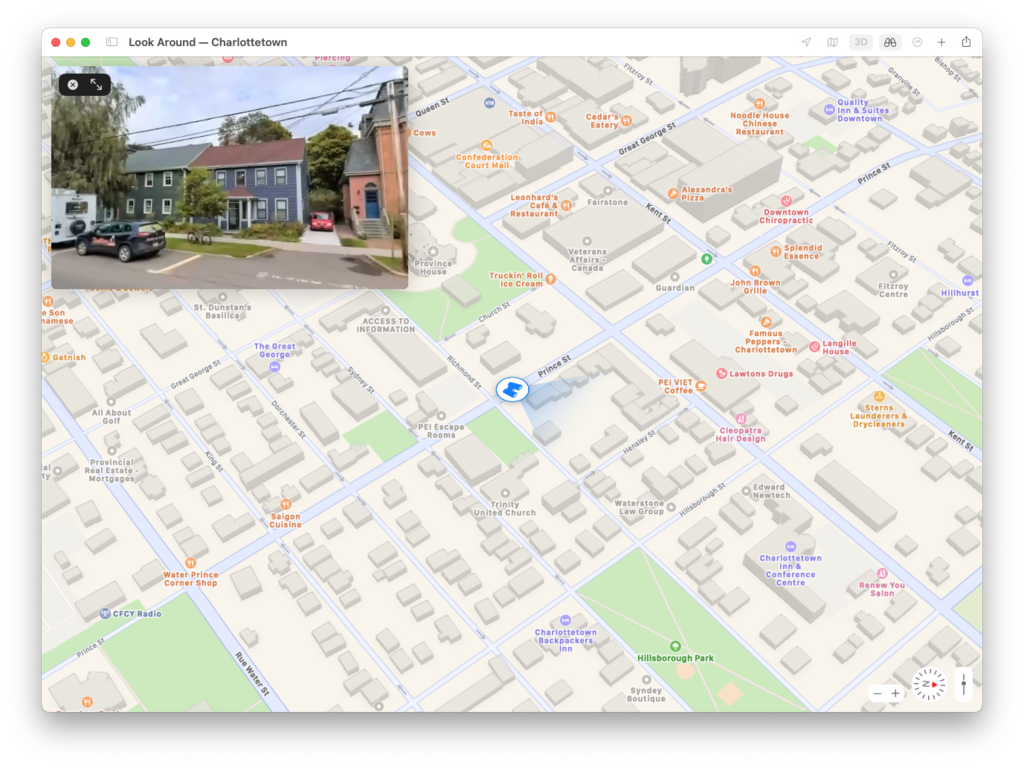
We’re still missing cycling directions, alas:
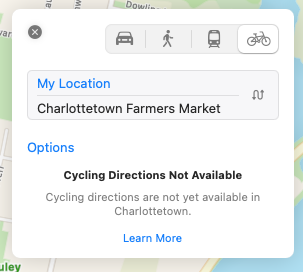
Walking directions are available, though, and a routing from my house to the Farmers’ Market shows the Confederation Trail as an option.
While the “look here” photos are old, the street map appears very up to date, with the displaced left turn system at St. Peters and Riverside, which opened very recently, already updated (at this writing Bing Maps is missing this, Google Maps has one half of the displaced left system only and only Here Maps is as up to date as Apple):
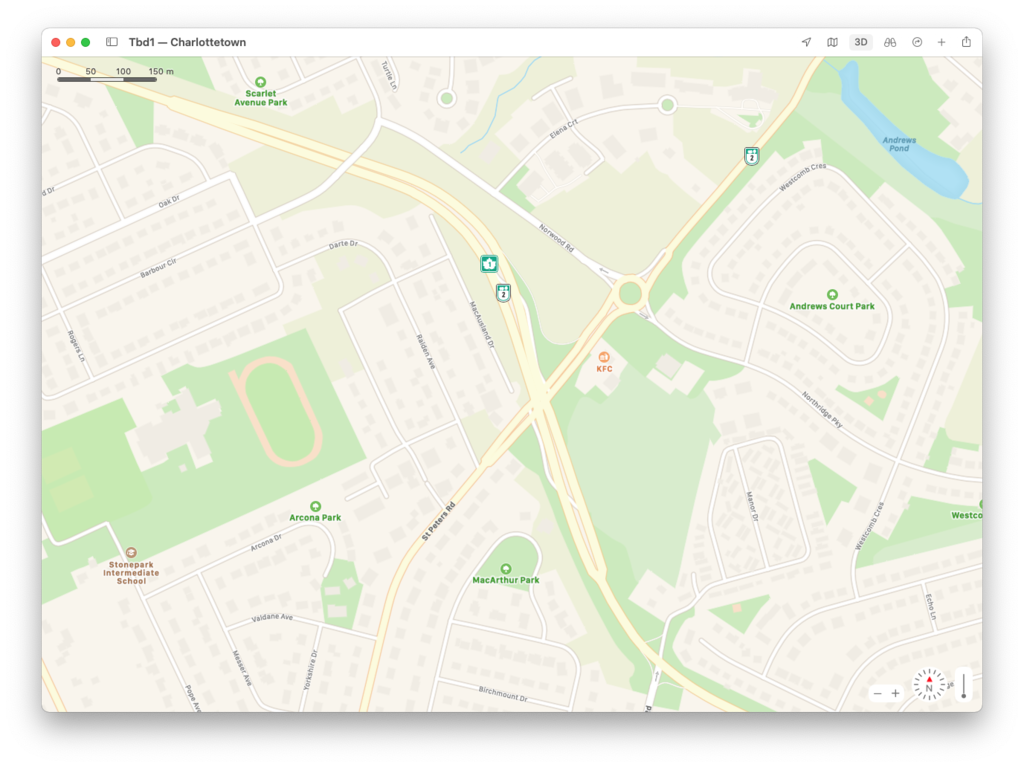
With 15 cm of snow in the forecast for tomorrow, I realized today might be my last opportunity to ride the new Riverside Drive active transportation path extension from Park Street to Grafton Street, recently paved as part of the Hillsborough Bridge Path project. So I took my bicycle back out of the basement and prepared for a late-autumn ride1.
The paving has only just completed–I imagine the asphalt was some of the last to flow from the asphalt plant before it closed for winter–and the path is rough and ready enough to not be entirely considered “open” yet (in part because there are no pedestrian/cycle signals installed yet at neither the Grafton St. nor Park St. intersections). But it’s certainly possible to cycle, so that’s what I did, en route to Riverview Country Market for a late-Saturday grocery run.
To get to the path itself from and back to downtown took some gymnastics: on the way there I rode along Richmond Street to Cumberland, through the Cumberland jug-handle, across the carwash parking lot to the gravel trail that goes around the perimeter of the event grounds to the corner of Riverside and Grafton, and then up the path to Riverview Country Market. On the way back I took an alternate route, around the other side of the event grounds, then along Water Street to Prince and home.
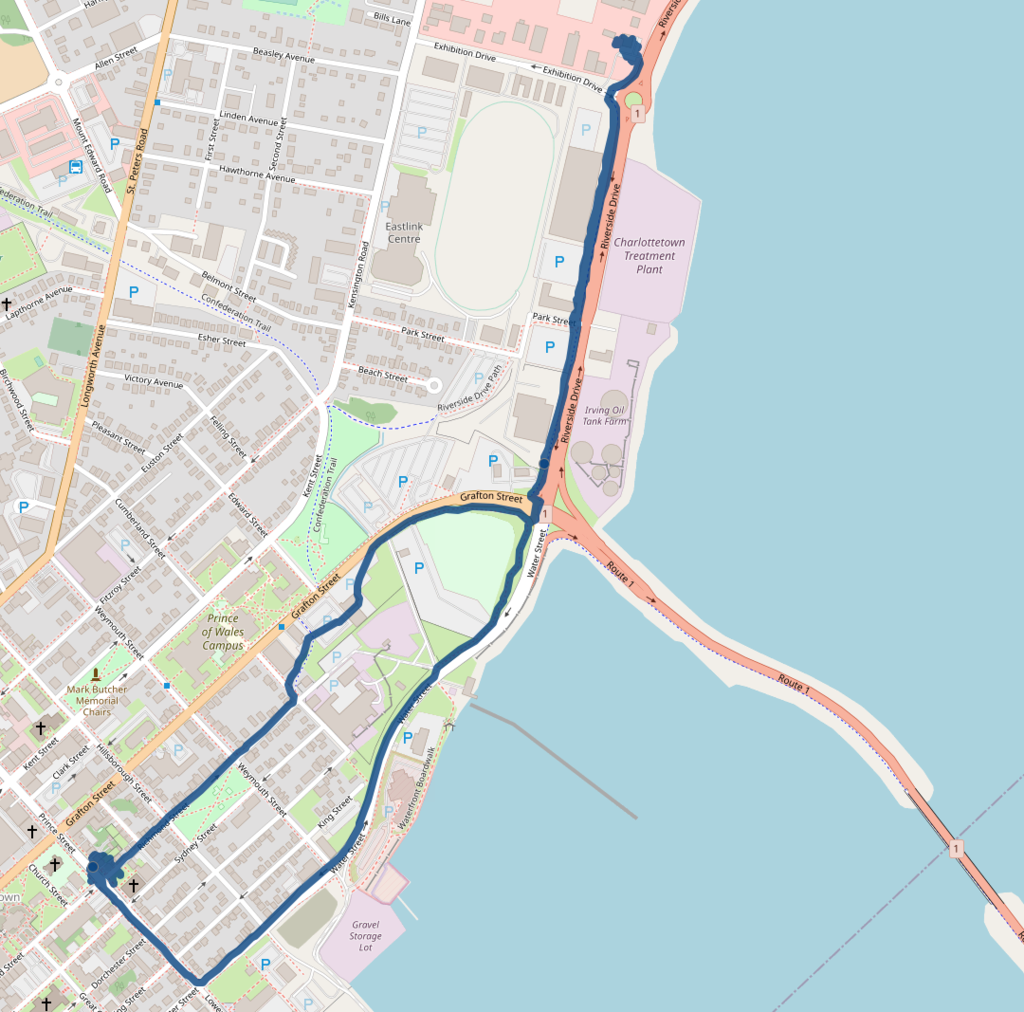
One of the foundational tenets of Bike Friendly Charlottetown has been that by joining existing routes in the city together, we can achieve a safe, interconnected cycling network without needing to build from scratch: this path is one example of that. Once it’s formally wired up to the Hillsborough Bridge Path, and the intersections are signalled, it will become an important new link; when the path from the Queen Elizabeth Hospital to Mount Edward Road is finished next year, it will become even more valuable.
Bravx to the provincial government for having the foresight to build this extension into the Hillsborough Bridge project.
1. In taking my bicycle back out of storage today, I extended cycling season by 10 days over last year, making for a total cycling season, starting April 18, 2020, of 238 days, or 65% of the year.
Elderflower Farm Brussels sprouts and and veggie ground over sushi rice with a yoghurt-tahini-lemon sauce.
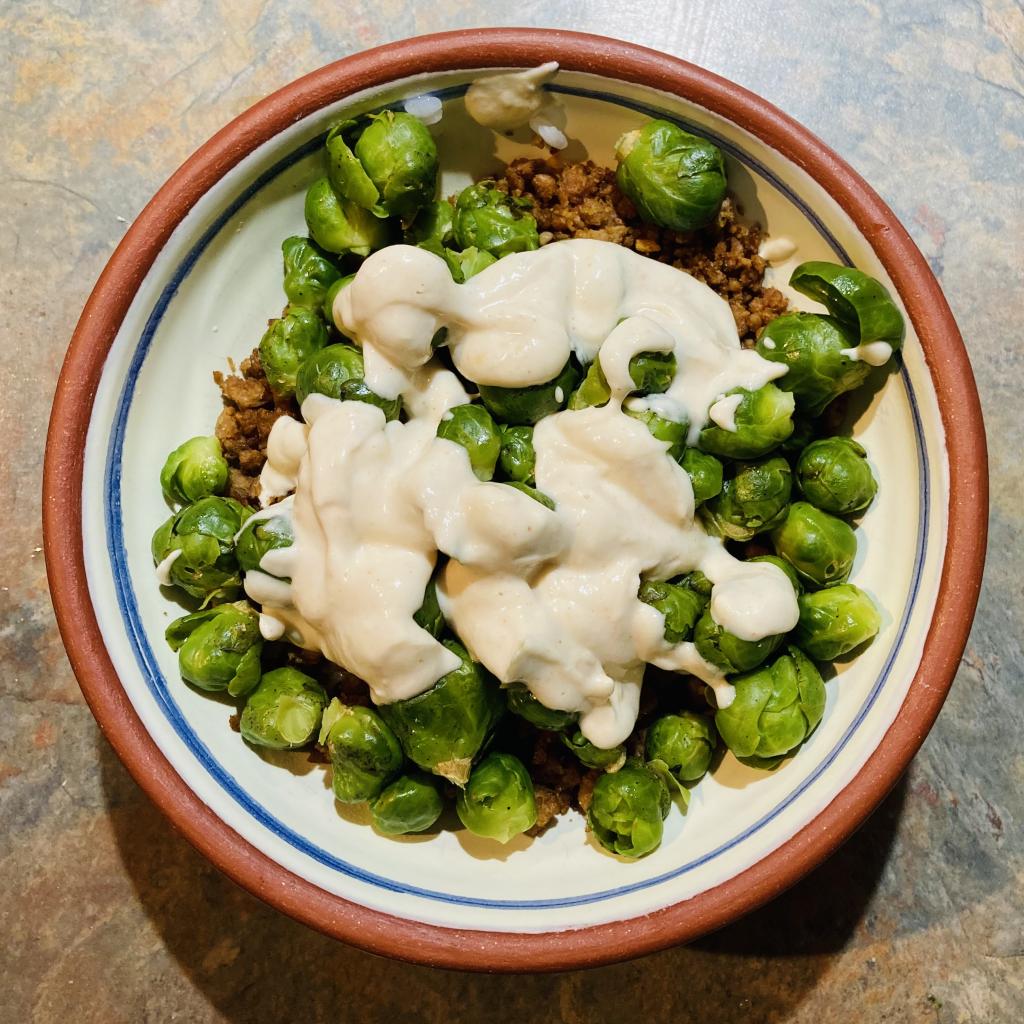
For the historical record, evidence of the new “pop your hat up to let you put your mask on” move that winter weather now requires.
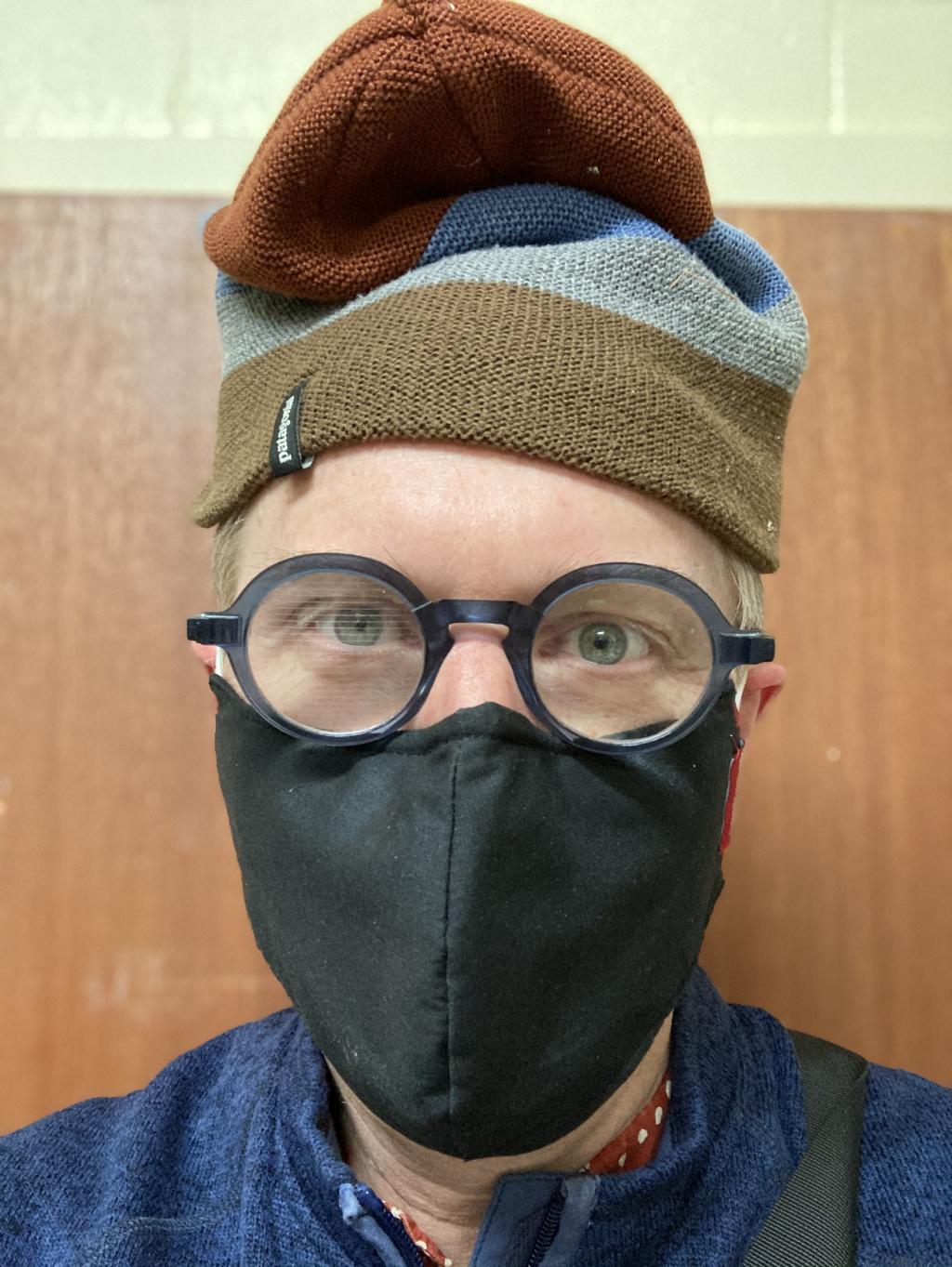
Guardian reporter Jim Day interviewed me over the telephone this morning about Using Her Marbles, an interview that had extra depth to it because it was in a front-page interview by Jim for The Guardian in 2016 that Catherine “went public” with her cancer.
Jim started at the paper the same year we moved to Charlottetown, in 1993, and it’s been more than once over those years that his journalistic gaze has overlapped with our household’s interests: I have always found him to be a reporter unusually invested in his subjects, an asker of meaty questions, and a skilled writer.
Jim and I spent almost an hour on the phone this morning, and beyond the journalistic purpose of our chat, I found the interview extremely therapeutic. “Who was Catherine?”, Jim asked me, for example; nobody had ever asked me that before, and the process of answering that question took me places I hadn’t yet been.
Jim’s story will run in the paper in the coming days, I imagine.
Jim himself retires after 27 years of service to the paper and to the Island, at the end of this month; you wouldn’t be out of line if you sent him an email thanking him for being someone who has skillfully reflected the Island and its people and, on occasion, allowed us to look deeper inside ourselves.
From the evy’s garden manifesto:
Sleep with airplane mode on. Resist the urge to check my phone when I wake up. If I see a stressful message in the vulnerable moments after waking up, it can affect my mood for hours. It’s also easier to get out of bed if I’m not browsing the internet. Don’t just get out of bed, brush my teeth and complete at least one task before turning airplane mode off.
Sage advice that I rarely follow. My phone is the first thing I look at in the morning, and I’ve developed the habit of ticking off a series of digital boxes before I even get out of bed: CBC, The Guardian, CNN, New York Times, weather, electricity demand, Hacker News, etc.
Thinking of those engine-warning minutes as vulnerable is helpful, and leads me to realize the outsized effect my success or failure at completing the New York Times mini-crossword in under a minute has on my mood for the day.
(via Paul Capewell)
They moved the peanut butter at Sobeys on Allen Street a few weeks ago. It was just a couple of shelves up, but that I found it as temporarily debilitating as I did reinforced how well-worn the Sobeys aisles have become to me, and what a hair-trigger debilitation threshold I have.
My mother made a casual comment this summer about stirring peanut butter being a good thing; I’d never done this despite the clear call to action on the lid (which I had always dismissed as an ignorable on the plane of “coffee may be hot” and “contents may have settled during shipment”).
But my mother is wise, so I gave it a tentative try, sticking a big spoon deep into a freshly uncorked jar and mucking about. It helped, especially when the dregs, a few weeks later, were less dreggy.
So last week I kicked things up: I emptied the peanut butter from its jar into our immersion blender cup and went to town. The immersion blender was clearly at the edge of its operational limits, but it didn’t conk out, and when I decanted the peanut butter back into a glass jar it was wonderfully smooth. And has continued to be spreadable and luscious in the days since.
Score one for mother-wisdom (and, sometimes, reading labels).

Nineteen years ago today, Catherine and Oliver and I were in Boston on a beta test for international travel, in anticipation of a planned trip, two months later, to Thailand.
Taking Oliver to Thailand when he was 18 months old was the craziest most amazing thing we ever did together as a family, and it set such a high water mark for what we were capable of that it enabled us to pursue countless travel adventures in the years to follow.
The Boston trip was the starting line.
It was a year ago this week that we traded in our 2000 VW Jetta for a 2016 Kia Soul EV, and thus traded gasoline for electricity as the source for our transportation energy (I have not visited a gas station in more than 365 days as a result; I do not miss it).
The spark of the kernel of the idea for moving to a battery-electric car came from Karri Shea who, at the memorial for her late husband Josh Underhay, laid down a challenge:
Please don’t let their deaths be only a senseless tragedy, let them be a call to action and a catalyst for a change that you make in your life. For Prince Edward Island, for the world. Plant a tree, donate blood, put solar on your roof, buy an electric car.
From the planting of that idea, Trudy White, friend of the blog from the east, enhanced the momentum by showing up one day, weeks later, to take me for coffee in her brand new Chevy Bolt; a few weeks after that she let me drive the Bolt to a meeting of the electric vehicle association in South Melville, where I got to meet a ragtag group of EV owners and aspirants who, one by one, successfully batted away any of my lingering doubts.
I continued to dip my toes in the water by renting a Bolt to drive from Montreal to New Hampshire and back in September, which proved a success.
It was at that spring meeting of the EV group that Mike Kenny announced his plans to open up an all-EV dealership, a plans came together over that summer, so that by November we could take a Kia Soul EV he’d just imported from Quebec for a 24 hour test drive.
Catherine proved the catalyst for the final push: she could see how antsy I was about continuing to drive the Jetta, and how I couldn’t conscience replacing it with another gasoline powered car.
In the end, buying the Kia Soul EV we’d test driven a month earlier was the last thing we did together, as a couple. We picked it up on December 3, a cool, rainy, late autumn day not unlike today.
The thing that pleases me the most about all this is that the story from there is, well, pretty mundane.
A year ago tonight we took our first “long distance” trip, to Victoria (the last trip we ever took together as a family, as it happened). We got a level 2 charger installed on the side of our house. Oliver and I drove to Halifax and back in July, and to Cape Breton and back in September. Otherwise, we used the car for regular everyday things: trips uptown for groceries, trips to the beach in the summer, trips to the doctor. With COVID-19 it’s difficult to say that it’s been a typical year for car travel, as there have been far fewer places to go; but the places we did find to go, the Soul took us there.
As to the Soul itself, I’ve no complaints whatsoever: it just works. It hasn’t needed any maintenance over the last year (save for a replacement windshield, my fault, and switching out the winter tires). It doesn’t need fluids (other than washer fluid). And, to be honest, the futuristic sheen of driving a car made in 2016 (Bluetooth! CarPlay! heated seats! air conditioning!) after driving a car made in 2000 (cassette player! turn signals!) has yet to wear off.
The only time I’ve experienced range anxiety, an often-cited reason to avoid electric vehicles, is on our trip to Cape Breton, where the high speed EV charger in Monastery was offline when we arrived, meaning we had to drive into Port Hawkesbury and use a slower level 2 charger; otherwise, it’s not a factor. This is, mostly, because 95% of our trips are within 20 km of our house, so we’re never far from a charger at home or otherwise. Worrying about charging simply isn’t a fact of our daily life with the car: we go somewhere, we come home, I top up the car to 80% with the home charger in a couple of hours or less, and we’re ready to go somewhere else.
In the end, being an EV owner seems pleasantly normal rather than cutting-edge-revolutionary. If your travel patterns are similar to our own–and I imagine that’s true for many households–and you’re looking to replace a fossil-fuel-powered car, it’s hard to make the case for anything other than buying a used EV (Mike, who in the year since our purchase, has amalgamated Pure EV into the larger All EV, has plenty of vehicles available, starting at $12,000).
Kathy Parker, writing in Elephant Journal :
To you, dear woman, who is lost and without a trail to find your way home. I know what it means to be lost. Lost somewhere in the middle of the woman you once were and the one you are yet to become.
To long for a wilderness that is not yours to have; to be challenged, stretched, and broken. To ache for a pilgrimage or just for a holy moment that defines you—heals you and transforms you.
(via a path through Martin and Pam Frampton)
 I am
I am